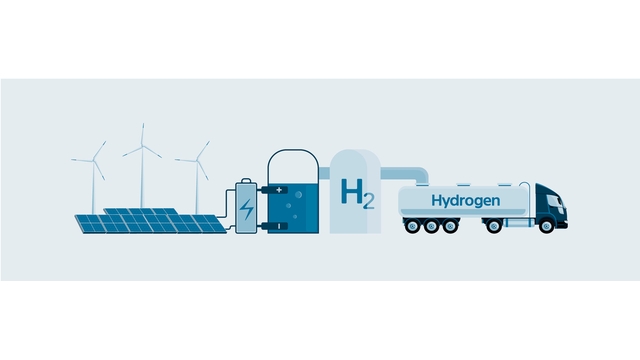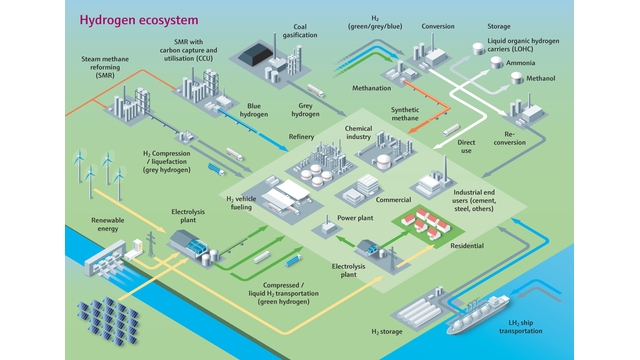Hydrogen economy: Fuel of the future, being developed today
Hydrogen provides promise as a significant energy source, but making the hydrogen economy viable at scale requires further research, innovation, policy support and infrastructure development

Tóm lại
- Despite challenges in infrastructure and adoption, hydrogen's clean burning and high-density energy storage characteristics position it as an alternative energy frontrunner.
- There are various methods of producing hydrogen, with each classified as a “color” correlated with the method’s carbon intensity.
- The hydrogen economy holds promise as a clean, versatile energy carrier for transportation, power generation and energy storage, potentially mitigating climate change and fostering economic growth.
- Despite its potential, high production costs, underdeveloped infrastructure and emerging safety protocols remain hurdles for widespread hydrogen adoption.
- Government investment, tax incentives and public outreach are key to establishing the hydrogen economy.
- Beyond its current uses, hydrogen reliance has the potential to reduce carbon emissions in hard-to-abate sectors like steel, chemicals and aviation, among others. Hydrogen can supplement, or even replace in some applications, natural gas at scale for cleaner power generation and heating.
- Global, collaborative research, innovation and incentives are needed to further develop hydrogen as an economically-viable clean energy carrier.
Hydrogen-powered potential
As the effects of global climate change mount, there is a need to augment energy supplies with clean, sustainable sources. Among the energy mix, hydrogen has many advantages, creating the potential to revolutionize the way we power our world through the hydrogen economy.
Hydrogen is the most abundant element on the periodic table, although it is not freely available and requires chemical processing for production. Its high energy content and zero-carbon-emission properties make it a sustainable and compelling alternative to conventional fossil fuels for energy storage and power generation.
Insights
Hydrogen's high energy content by mass and zero-carbon-emission properties make it a compelling alternative to conventional fossil fuels for energy storage and power generation.
When used as a fuel, hydrogen releases only water vapor and with a diverse range of production methods, it can be produced, stored and consumed on demand. Additionally, hydrogen is transportable, albeit with significant challenges, increasing its flexibility and reliability as a consistent energy source.
As with most industry initiatives, however, developing the hydrogen economy and adopting hydrogen-powered processes comes with several challenges, primarily related to the lack of existing infrastructure and regulations.
The primary colors of hydrogen
One of the first steps of understanding the hydrogen landscape is recognizing the various means of obtaining or producing it, each with various financial, sustainability and regulatory implications.
Like any consumable, hydrogen can only be as clean and eco-friendly as its production method. A color-coded system is used to distinguish the level of hydrogen’s environmental friendliness. There are even more colors in the palette, but these are the leading alternatives, with methane being the primary component of natural gas.
![The primary colors of hydrogen [placeholder pic]](/__image/a/9631461/k/1c977e7980f39978e55e3bbd0611de79b85ed709/ar/16-9/w/640/t/jpg/b/ffffff/fn/hydrogen.jpg)
- Grey hydrogen: Currently the most prevalent method of production, grey hydrogen is derived from natural gas through steam methane reforming (SMR) or autothermal reforming (ATR). While these processes are cost-effective, both release significant amounts of carbon dioxide into the atmosphere, negating most environmental benefits of using grey hydrogen as a fuel.
- Blue hydrogen: Similar to grey hydrogen in its reliance on natural gas SMR and ATR, blue hydrogen incorporates carbon capture and storage (CCS) technologies to capture and sequester carbon dioxide emissions generated during production. This method is considered more sustainable due to CCS, but this also makes it more expensive. ATR is better suited to blue hydrogen production because it produces a purer stream of carbon dioxide than SMR.
- Green hydrogen: Green hydrogen is produced through electrolysis, a process that uses renewable electricity from clean energy sources like wind, solar, or hydro power to divide water molecules into hydrogen and oxygen. This method creates no carbon emissions, making it the most sustainable option. Production costs and renewable energy supply are a concern, however.
- Turquoise Hydrogen: An emerging technology, turquoise hydrogen production utilizes methane pyrolysis, which requires decomposing methane - the primary component of natural gas - into hydrogen and solid carbon. While still in development, this method provides a low-emission alternative to grey hydrogen when the carbon byproduct is utilized or sequestered effectively.
Ushering in the hydrogen economy
While very much in its infancy, the hydrogen economy is beginning to take shape, displaying versatility and potential for widespread global adoption. Hydrogen is already a substantial element in numerous industrial processes, from ammonia production for fertilizers, to refining processes for petroleum products.
In the transportation sector, fuel cell electric vehicles (EVs) powered by hydrogen are gaining momentum, providing a zero-emission transportation alternative, with much faster refueling times compared to battery-powered EVs in minutes instead of hours. Hydrogen can also be utilized in stationary fuel cells for power generation, providing reliable electricity for homes and businesses, particularly in remote areas and regions with limited grid access.
Additionally, hydrogen is an efficient energy storage medium, especially geared toward capturing excess renewable energy produced during peak periods so it can be stored for later use. Unlike batteries - which are better suited for short-term energy storage - hydrogen's ability to stockpile large amounts of energy for extended periods makes it ideal for seasonal storage, helping address fluctuations in renewable energy production. Compared to battery storage, hydrogen storage requires much less space and weight, with virtually no energy loss over time.

Supplementing fossil fuel-based power generation methods with hydrogen-sourced energy will help address many of the pressing climate challenges humanity and the planet face today, particularly regarding greenhouse gas emissions. As the hydrogen economy develops, businesses are empowered to mitigate climate change and achieve corporate sustainability goals.
Insights
Supplementing fossil fuel-based power generation methods with hydrogen-sourced energy will help address many of the pressing climate challenges we face.
Furthermore, hydrogen increases energy security by diversifying energy supplies and reducing dependence on conventional energy sources that can be increasingly impacted by geopolitical dynamics. The hydrogen economy is an opportunity for fostering innovation, creating new industries and jobs, and stimulating economic growth across the value chain. The addition of hydrogen-powered industrial processes also reduces airborne pollutants, resulting in improved air quality - particularly in densely populated areas - and public health benefits.
Adoption hinderances
Despite the upside, hydrogen faces several barriers to widespread adoption.
First, while green hydrogen provides a zero-emission option for powering infrastructure, it remains significantly more expensive to produce energy with than traditional fossil fuels. Decreasing the cost of green hydrogen production is one of the top priorities for spurring the hydrogen economy.
Similarly, blue hydrogen adds significant costs to grey hydrogen production, so incentives will be required to increase its use.
Additionally, hydrogen lacks robust and developed infrastructure for production, storage, transportation and distribution. Establishing these facets requires significant investment in building out new and adapting existing infrastructure to handle hydrogen safely and efficiently. It also necessitates public trust and acceptance of hydrogen technologies into industrial and consumer-grade processes, which require awareness campaigns to educate about the benefits of hydrogen, address safety concerns and dispel myths.
Finally, safety protocols and regulations throughout the entire value chain must become widely known and understood, ranging from production and storage methods to transportation and end-use. Regulatory agencies play a significant role in both educating current and potential hydrogen users and in incentivizing its adoption.
Regulatory landscape and policy
Governments and regulatory bodies play a crucial role in fostering the development of a thriving hydrogen economy through targeted policies and incentives. These frequently manifest as carbon taxes, renewable energy credits, or cap-and-trade emissions allowance systems that make green power more attractive from a business standpoint. For example, the United States’ 2022 Inflation Reduction Act includes clean energy tax credits and other provisions to increase domestic renewable energy production. Meanwhile, Japan and South Korea each committed to carbon neutrality by 2050, and the entire European Union is following suit.
Beyond setting policy, governments are also funding research and development, which is critical for reducing the cost of green and blue hydrogen production, improving the efficiency of hydrogen technologies and exploring new applications for this versatile energy carrier. Public funding and incentives can accelerate the deployment of hydrogen refueling stations, pipelines and storage facilities, creating a robust infrastructure that supports increased adoption.
Public entities also play a necessary role in establishing clear safety protocols and regulations in the hydrogen value chain. Reinforcing these practices is paramount to ensure public safety and establish confidence in hydrogen technologies.
New horizons
Given the hydrogen economy’s early stages, potential applications extend beyond current uses. For example, industries like steel and cement production - known for their large carbon footprints because of energy-intensive manufacturing processes - are actively exploring hydrogen supplements to fossil fuel-based energy to reduce environmental impact.
Reducing carbon emissions in the maritime and aviation sectors, which are heavily reliant on fossil fuels, has also proven challenging. However, hydrogen fuel cells powering combustion engines provide potential solutions.
Hydrogen is even being blended in conventional natural gas-fired power generation facilities to reduce carbon emissions to the atmosphere. Newer gas turbine designs can now use hydrogen alone as a fuel source, with no natural gas blending required.
At the consumer level, hydrogen blended with natural gas at up to 20% of the total mix can be used in residential and commercial applications with no modifications needed to existing appliances - such as heating systems, stoves, hot water heaters and clothes dryers - providing another avenue for reducing carbon emissions and promoting healthier living environments.
The maturing hydrogen economy
Developing a robust hydrogen economy will not occur in solitude. It instead requires a collaborative approach among all stakeholders, including manufacturers, suppliers, public and private research institutions, governments and the public. Further research and development, along with additional pilot projects, are essential for driving innovation, reducing cost barriers, overcoming technical challenges and ensuring safety.

While challenges remain, hydrogen utilization offers numerous benefits as the world seeks to reduce carbon dioxide emissions and supplement current power supplies with sustainable green energy. Navigating adoption challenges requires continued research, education, technological innovation and policymaking unity, but the use of and potential for hydrogen is continuing to scale up, presenting a key opportunity to power a cleaner future for industry and beyond.



